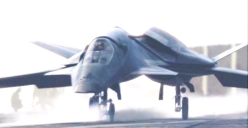Difference between revisions of "AR-11 Phantom III"
From TheHolo.Net Forums Wiki
Tom Harriman (Talk | contribs) (Created page with "<center>Image:TSi.jpg</center> {{Infobox_Misc | Title=A-11 Phantom III | Image=A-11 Harpy.jpg | Name=A-11 Phantom III<br>X-39 JSF | Details=Carrier-based attack aircraft<...") |
Tom Harriman (Talk | contribs) m (Tom Harriman moved page A-11 Phantom III to AR-11 Phantom III) |
| (One intermediate revision by one user not shown) | |
Latest revision as of 01:05, 16 October 2013
X-39 JSF
Joint Strike Fighter candidate
The A-11 Phantom III is a twin-seat fifth generation attack aircraft developed as a counterpart to the F-22 Raptor and the F-35 Lightning II.
History
The A-11 began as a candidate for the Joint Strike Fighter program, under the designation X-39 JSF. Having developed another high speed and stealth-capable fighter decades earlier in the form of the YF-19 Photon, Treadstone felt that it had a significant head-start over it's competators.
The Photon had originally been designed purely for air-to-air missions however, and so Treadstone radically reworked the design. While the Photon had featured a "quinjet" design, the new X-39 featured only three engines: two conventional jets for forward thrust, and a third with a vectored exhaust to provide VTOL capabilities and additional forward thrust when required. Treadstone hoped that this unique approach would set their craft apart from competators, allowing pilots to apply vertical and horizontal thrusts simultaneously. To increase stability at low speeds and while "hovering", Treadstone added forward-sweeping switchblade wings, which would fold away at high speeds.
The space that was gained by saccficing two engines was given over entirely to expanding the weapons capacity of the craft; the airframe itself also became considerably larger to accomodate the necessary electronics, incorporate smoother radar-scattering surfaces, and to provide additional lift across the entire surface of the craft similar to the concepts behind a flying wing.
Unfortunately, while the X-39 posessed the speed, stealth, and firepower that the JSF program called for, it was deemed to be too large and insufficiently agile; the JSF contract was ultimately awarded to Lockheed Martin.
However, that wasn't the end of the X-39. Seeing it's potential as a replacement for the F-117 Nighthawk, and a stealth alternative to the A-10 Thunderbolt, S.H.I.E.L.D and the United States Air Force funded the plane's redesign as a Stealth Assault Fighter.
Out of Character
In real life, the designation "X-39" was never applied to an aircraft, though it was reserved by the Future Aircraft Technology Enhancements (FATE) program of the United States Air Force in 1997. It was selected because of it's similarity to X-32 and X-35, two other planes from the Joint Strike Fighter program.
The "A-11" designation was also reserved but never used. It was possibly intended as a designation for the F-117 Nighthawk.
The Harpy's appearence is based on the fictional F/A-37 Talon from the movie Stealth.


